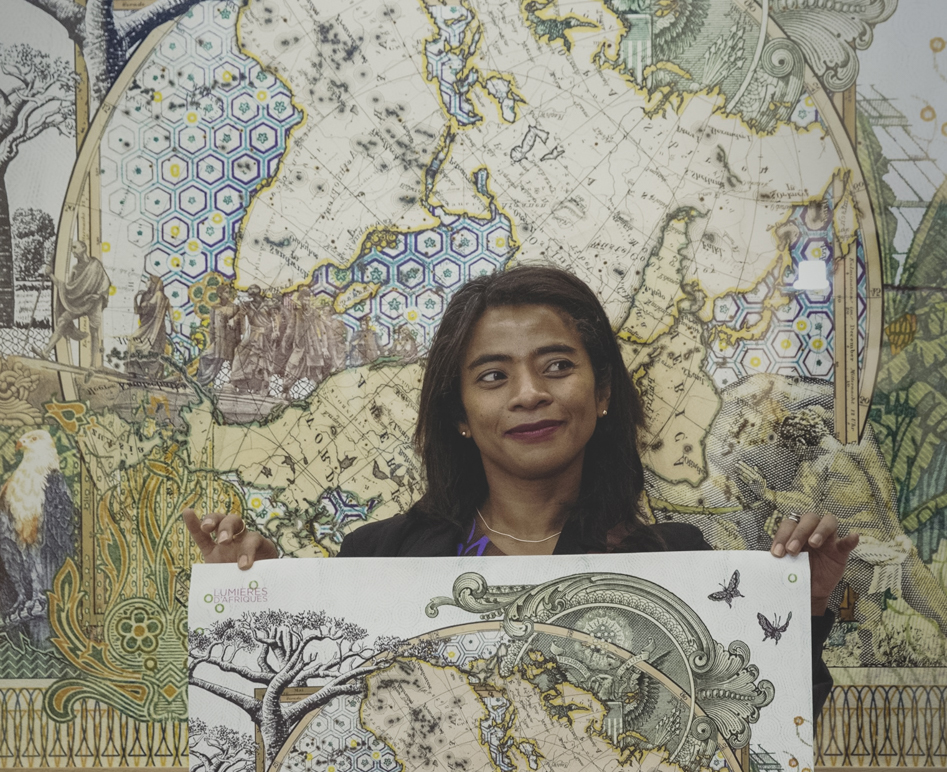Prix AWARE
Portrait of Malala Andrialavidrazana by Matthieu Lombard
Courtesy AAD Fund
“The past is never dead. It’s not even past.”
William Faulkner
Over the last two decades and through her progressive travels, the French-Malagasy artist Malala Andrialavidrazana has developed a profound reflection on the dysfunctional reality of geographic boundaries and of the colonial political inheritance which has defined the conditions of the “global.” From her beginnings, the artist has looked for the realities of a multiple and polyglot history, which enable a reconfiguration of the cartography of places as well as their destabilisation. Drawing freely on all visual media – photography, digital collage, publishing – her works uncover a contemporary diasporic experience made up of intercultural associations, transhistorical impressions, and family relations. Investigating little-known realities, freeing herself from the stereotypes bestowed by history, Andrialavidrazana works to operate a seismic shift of worlds which echoes that of images, and emphasises what they have in common: the search for a gaze modified by polyphonic globalities.
The artist’s territories are made up of successive networks and circles, of an expansion of the horizons of the visible and the hidden. As strategies for deterritorialising and peeling back the layers of the known, her works seek to offer new perspectives on the processes of displacement, substitution, or projection. Faithful to an ideal of thought-action, they embody a form of resistance to any limiting notion of affiliation to an identity or a territory, replacing the global with the “texture” of “co-localities”, to quote the Filipino art historian Patrick Flores1.
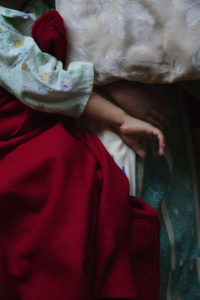
Ny Any Aminay, 2011, tirage numérique
© Malala Andrialavidrazana
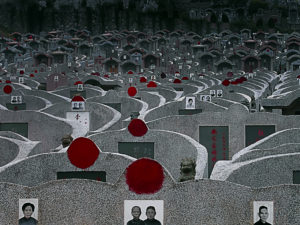
d’Outre-Monde – Guangzhou, Daguan Nanlu, 2003, tirage numérique
© Malala Andrialavidrazan

Echoes (from Indian Ocean), 2011-2013, tirage numérique
© Malala Andrialavidrazana
In this work of rewriting, private lives are at stake. The artist was raised in a multi-ethnic family context and at the heart of the struggles and divisions that shook Madagascar at the beginning of the 1970s, that left their mark on the family’s fate. This native country that Andrialavridrazana left at 12 years old is central to her early research and to the architecture degree that she earned in Paris in 1994, which focused on the utopian project of a multi-ethnic necropolis. In her photographic works, the “island of syllables of flame” as Madagascar was termed by the poet and statesman Jacques Rabemananjara2, asserts itself in a perpetual return, from Tanindrazana / The Ancestors’ Land in 2005 and Ny any aminay in 2011 to her cross-border projects such as D’Outre-Monde in 2003, which builds on the artist’s research on funerary architecture in cities and places across the Global South: Madagascar, South America, Asia, Australia, New Zealand… Between 2011 and 2013, the huge project Echoes (from Indian Ocean) examined the private and personal to reveal the relational space of the entire Indian Ocean, from one “cousin” town to another: Tanarive, Réunion, Mumbai or Durban. The artist sketches the outline of a sensitive anthropology, which she captures in fragmentsand appearances in the course of objects and human figures present these spaces. An intimate geography connects these abandoned or arbitrarily separated coordinates, and emerges through the prism of a connected Afro-Asian history.
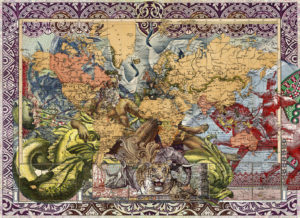
Figures 1853, Kolonien in Afrika und in der Sud-See, 2016, tirage pigmentaire sur papier Hahnemühle Cotton Rag, 110 x 151,5 cm
© Malala Andrialavidrazana
Since 2015, the Figures have reaffirmed her total commitment to rewriting history and the geographic coercions inherited from colonial cartographies. The Figures are deconstructions of dominant historiographies, which are based on the reinterpretation of maps and archives from visual sources created by States (banknotes, stamps) or emanating from cultural production (record covers, illustrated albums). These printed images shape social imagination as they pass from hand to hand. They are collected and archived by the artist, then reproduced in “woven” recompositions that travel through time and geographic expanses, just like their component visual material.
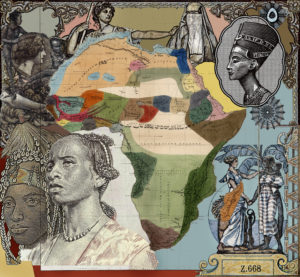
Figures 1861, Natural History of Mankind, 2016, collage, épreuve pigmentaire UltraChrome sur Hahnemühle Photo Rag
110 x 130 cm
© Malala Andrialavidrazana
As is often the case in the work of Andrialavidrazana, oceans play a decisive role, appearing as vital spaces of the circulation of ideas and practices. The Indian Ocean reappears, in its multiple directions and its “Afrasian imagination”, as referred to by professor of literature Gaurav Desai3. At the heart of the Figures, the recurring image of Neptune embodies the impetus of the most ancient explorers hurtling into the unknown. The relationship with water and its myths brings us back to a key, ahistorical liquidity: a fluid circulation which contrasts with that of money and politics, procedural human practices which have all too often deformed historic time and geographic space.
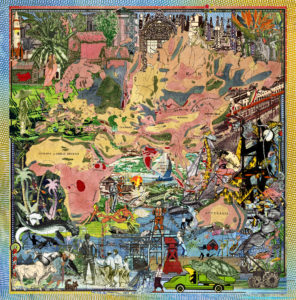
Figures 1853, Strata (remontage cadre), 2023, ultraChrome pigment print on Hahnemühle Ultra Smooth Cotton Rag, 110 × 106 cm
© Malala Andrialavidrazana
“Digital embroideries” in the artist’s own words, thorough digital photomontages which can reach a monumental scale, the Figures displace the intrinsic limits of cartography into a tool for augmented cognitive future. Sites of unexpected and significant encounters, they express possible transhistorical movements of worlds, geological upheavals of thought, and images in which the legacies of civilisation are stratified. An apparatus for reconstructing space and time, tending almost towards fiction, each of the Figures is like a subjective account of the vestige of images and their memories.
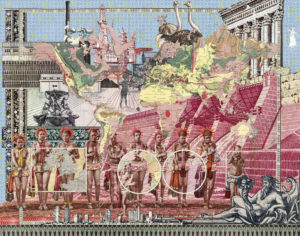
Figures 1856, Geological structure, 2018-2019, épreuve pigmentaire UltraChrome sur Hahnemühle Photo Rag, contrecollage sur aluminium et encadrée sous verre, 110 x 140 cm
© Malala Andrialavidrazana
A surface for the exchange and collision of narratives, Andrialavidrazana’s Figures are now moving towards a gradual complexification of composition and on an ever-larger scale, marking a return to the architectural dimension. From funerary architecture – the possible original source of the emergence of culture and the ultimate place of return – to domestic spaces and the cartography of worlds, it is the entire globe that is set in motion, as if it were able to shed the images that weigh it down, or be revealed by those that lift it up.
Olivier Zeitoun
Malala Andrialavidrazana, born in 1971 in Antananarivo, Madagascar, is a French-Malagasy artist and photographer living in Paris. A graduate of the École nationale supérieure d’architecture de Paris-La Villette (1996), M. Andrialavidrazana began her artistic career by expanding her investigations on Madagascar to cities of the Global South, through different series of photographs, in particular Outre Monde, which won the HSBC photography prize in 2003. Various series followed, enriched by cross-border travels, such as Echoes (from Indian Ocean) (2011-13), which outlines the plural singularity of the Indian Ocean. Since 2015, Figures have been visual combinations that combine photographs, collages, drawings and texts, leading to new forms of storytelling and historical narrative.
Andrialavidrazana’s work has been featured in several solo and group shows in France at the FRAC Réunion (2015, 2019), the Lyon Biennale (2017), the Musée des Beaux-Arts de Rouen (2021), the Cité Internationale des Arts de Paris (2022), the Résonances de la Triennale Art et Industrie at the Frac Hauts-de-France (2023), as well as numerous venues abroad: Rencontres de Bamako (2006), Triennale de Guangzhou (2008), Doual’art in Douala (2012), Fondation Calouste Gulbenkian in Lisbon (2013), PAC Milano (2017), the Karachi and Changjiang Biennales (2017), the Dhaka Art Summit (2018), the Centre Pompidou in Paris (2021), the Art Institute of Chicago (2022), the Sharjah Biennale (2023) and the Tate Modern in London (2023). Her work is part of the collections of the CNAP, the Fonds d’art contemporain – Paris Collections, and the Frac Normandie.
See Sylvia Tsai, “Salvage operation”, Art Asia Pacific, no 93, May-June 2015, and Simon Soon, “Signal and a perturbation : co-localities, language and facility” in Virginie Bobin, Mélanie Bouteloup, Victorine Grataloup, Élodie Royer and Émilie Villez (eds.), Qalqalah 2, Paris, Bétonsalon – Centre d’art et de recherche, Kadist Art Foundation, February 2016.
2
Jacques Rabemananjara, Antsa, Paris, Présence africaine, 1956.
3
Gaurav Desai, Commerce with the Universe, Africa, India, and the Afrasian Imagination, New York : Columbia University Press, 2013
Tous droits réservés dans tous pays/All rights reserved for all countries.



